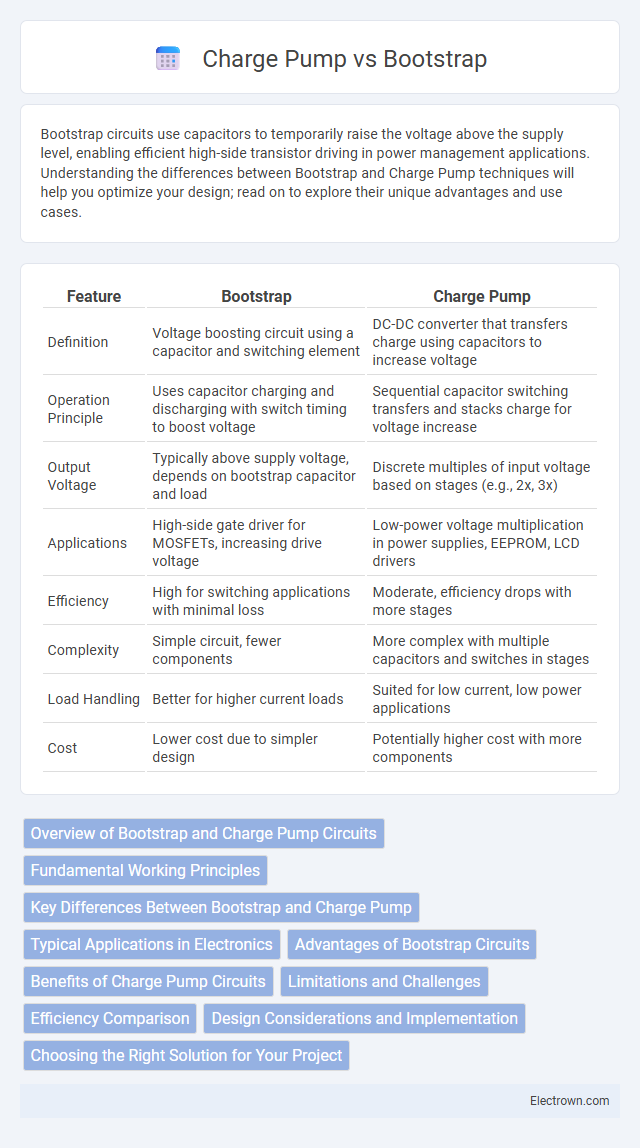Bootstrap circuits use capacitors to temporarily raise the voltage above the supply level, enabling efficient high-side transistor driving in power management applications. Understanding the differences between Bootstrap and Charge Pump techniques will help you optimize your design; read on to explore their unique advantages and use cases.
Table of Comparison
| Feature | Bootstrap | Charge Pump |
|---|---|---|
| Definition | Voltage boosting circuit using a capacitor and switching element | DC-DC converter that transfers charge using capacitors to increase voltage |
| Operation Principle | Uses capacitor charging and discharging with switch timing to boost voltage | Sequential capacitor switching transfers and stacks charge for voltage increase |
| Output Voltage | Typically above supply voltage, depends on bootstrap capacitor and load | Discrete multiples of input voltage based on stages (e.g., 2x, 3x) |
| Applications | High-side gate driver for MOSFETs, increasing drive voltage | Low-power voltage multiplication in power supplies, EEPROM, LCD drivers |
| Efficiency | High for switching applications with minimal loss | Moderate, efficiency drops with more stages |
| Complexity | Simple circuit, fewer components | More complex with multiple capacitors and switches in stages |
| Load Handling | Better for higher current loads | Suited for low current, low power applications |
| Cost | Lower cost due to simpler design | Potentially higher cost with more components |
Overview of Bootstrap and Charge Pump Circuits
Bootstrap circuits use a capacitor to temporarily raise the voltage supply above the source voltage, enabling high-side transistor switching in power electronics with improved efficiency and reduced gate drive requirements. Charge pump circuits generate higher or inverted voltages from a given supply by sequentially charging and discharging capacitors, often utilized in low-power applications for voltage regulation or level shifting. Your choice between these circuits depends on the specific voltage conversion needs, switching speed, and power efficiency requirements of your design.
Fundamental Working Principles
Bootstrap circuits operate by temporarily storing charge in a capacitor to raise the voltage above the supply level, enabling efficient high-side transistor drive in switching power supplies. Charge pumps use capacitors as energy transfer elements to convert voltages by alternately charging and discharging capacitors through switches, facilitating voltage doubling or inversion without inductors. Understanding these fundamental working principles helps you select the appropriate voltage boosting technique for your specific power management application.
Key Differences Between Bootstrap and Charge Pump
Bootstrap circuits use an external capacitor to momentarily raise the gate voltage higher than the supply voltage, enabling efficient high-side MOSFET driving without a negative rail. Charge pumps generate higher voltages by transferring charge through capacitors in a switched capacitor network, allowing for voltage multiplication or inversion. Key differences include bootstrap circuits requiring an active switching phase to recharge the capacitor, while charge pumps rely on clock-driven switching for continuous voltage conversion.
Typical Applications in Electronics
Bootstrap circuits are commonly used in switching regulators, power amplifiers, and motor driver circuits to enhance gate drive voltage and improve switching performance. Charge pumps are typically utilized in voltage doubler or inverter circuits, non-volatile memory programming, and low-power portable devices for voltage regulation without inductors. Each technology suits specific applications based on power efficiency, complexity, and required voltage levels.
Advantages of Bootstrap Circuits
Bootstrap circuits provide higher efficiency and faster switching speeds in power management applications compared to charge pumps. They typically offer better voltage regulation and reduced output ripple, enhancing overall circuit stability. Bootstrap configurations also enable simpler designs with fewer external components, resulting in lower cost and improved reliability.
Benefits of Charge Pump Circuits
Charge pump circuits offer significant benefits such as efficient voltage conversion without the need for bulky inductors, enabling compact and cost-effective designs. Their ability to generate higher or inverted voltages from a single power supply makes them ideal for low-power and portable applications. Charge pumps also provide high switching speeds and low electromagnetic interference, improving overall circuit performance.
Limitations and Challenges
Bootstrap circuits often face voltage drop limitations and increased power dissipation due to diode forward voltage losses, hindering efficiency in high-frequency applications. Charge pumps encounter challenges in achieving high output voltage with low ripple, as capacitor sizing and switching frequency directly affect performance and ripple noise. Both methods struggle with scalability and often require complex control mechanisms to maintain stable operation under varying load conditions.
Efficiency Comparison
Charge pumps generally offer higher efficiency at lower current loads compared to bootstrap circuits, which tend to lose more energy due to resistive elements and switching losses. Bootstrap circuits are simpler and effective for driving high-side MOSFETs in half-bridge configurations but exhibit decreased efficiency as load current increases. Charge pumps maintain consistent voltage levels with minimal power loss, making them more suitable for low-power applications requiring stable and efficient voltage conversion.
Design Considerations and Implementation
Bootstrap circuits offer simplicity and faster switching speeds, making them ideal for applications requiring efficient high-side driver implementations with low gate charge MOSFETs. Charge pumps provide higher voltage gain and better voltage efficiency, suitable for designs needing stable voltage levels and where space constraints limit external components. Your choice depends on specific design constraints such as power efficiency, component count, and switching frequency requirements.
Choosing the Right Solution for Your Project
Choosing between bootstrap and charge pump circuits depends on the voltage requirements, efficiency, and complexity of your project. Bootstrap circuits provide a simple, cost-effective solution for driving high-side MOSFETs in low-to-mid voltage applications, offering fast switching and minimal component count. Charge pumps deliver precise voltage conversion and higher voltage gains suitable for applications requiring stable voltage levels and efficiency across various loads.
Bootstrap vs Charge pump Infographic

 electrown.com
electrown.com